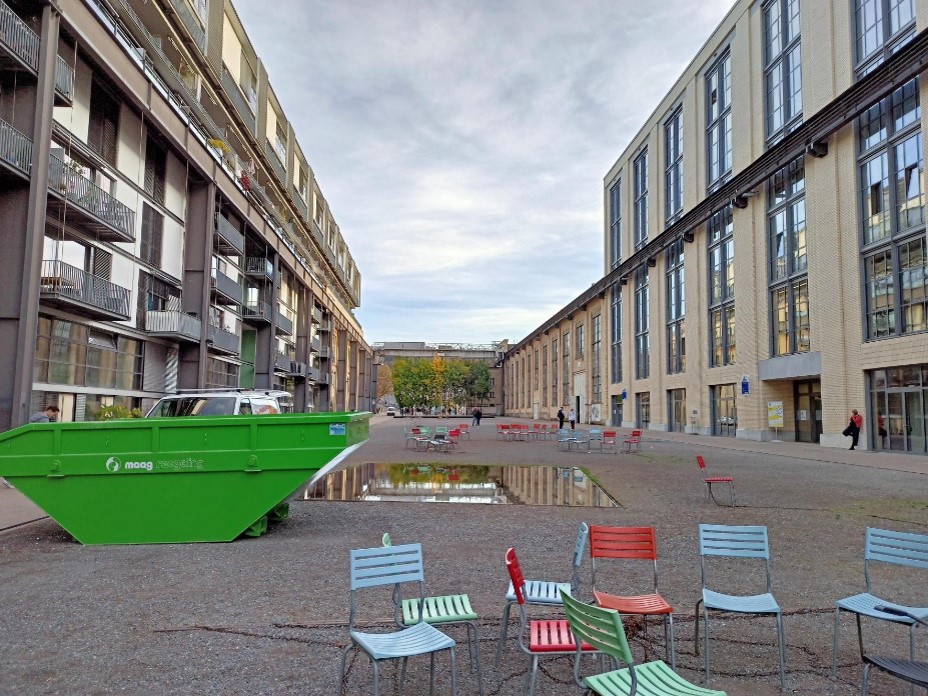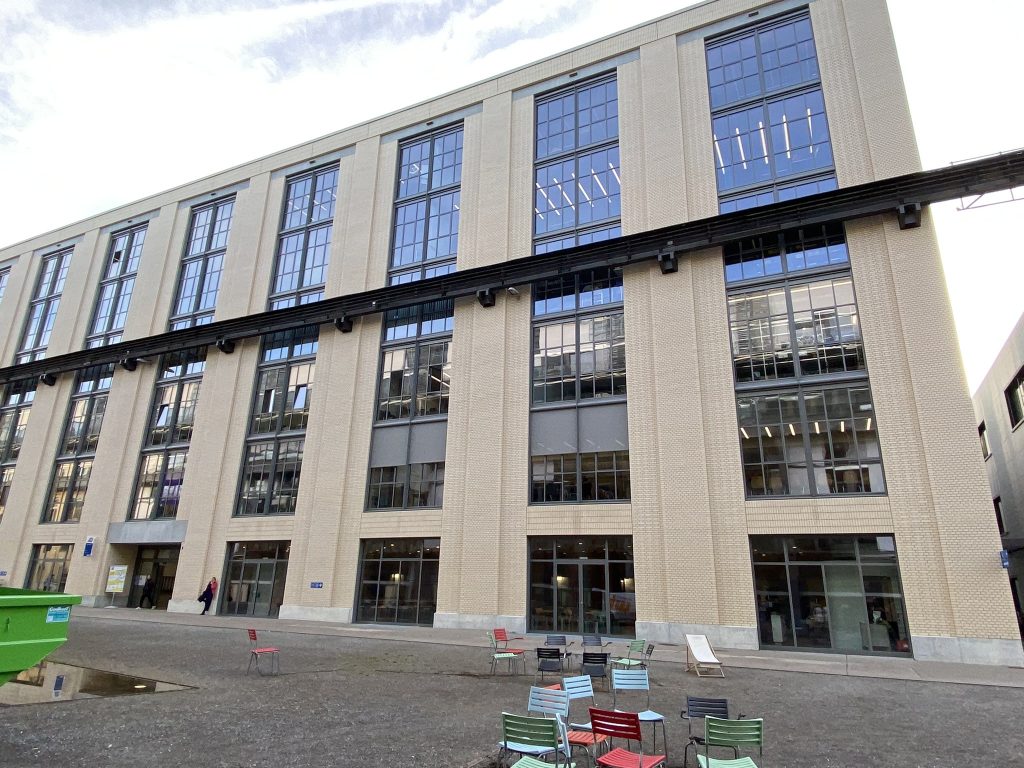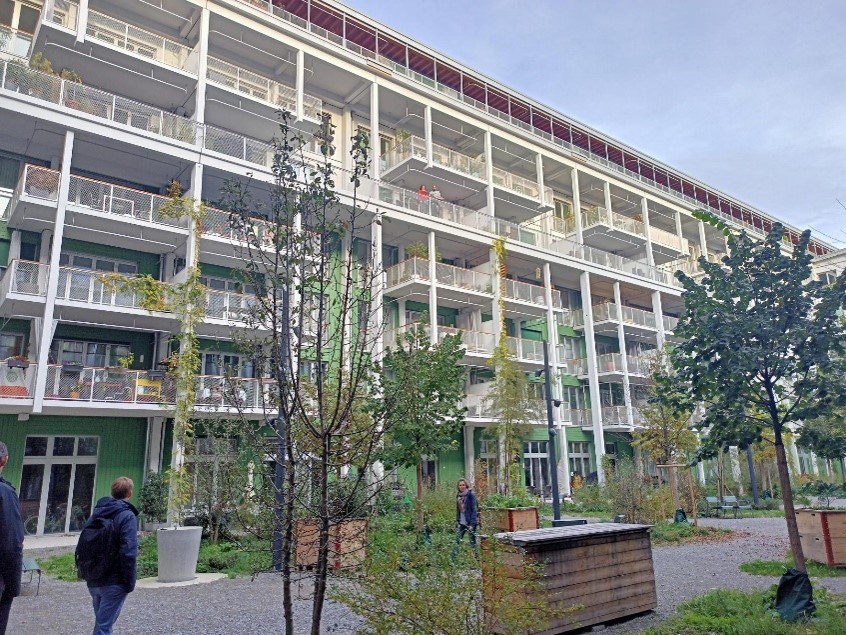Inclusive decarbonisation: the ambitious Lokstadt project in Winterthur

© Amélie Ancelle
November is not usually seen as a month which lifts up spirits. This was without counting on the city of Winterthur, the Swiss partner of our consortium, who took the project partners on a refreshing study tour in its eco-responsible neighbourhood in the making: the Lokstadt neighbourhood.
A new neighbourhood strongly anchored in the history of the city
The Lokstadt project is located on a part of the old site of the diesel engine maker Sulzer and the Swiss Locomotives & Machines factory (SLM). The industrial site, with a long history of production, was founded in 1834 and operated until 1989. Once shut down, Sulzer, still owner of the space, tried and find a way to bring back life in the area. After two first failed attempts in 1990 and 1992, the first successful housing project was awarded in 1999 and saw, in 2004, the “Kranbahn” housing project come out of the ground. This marked the start of a new use of the area, with the construction of a building for the city government and the refurbishment of the former test facility for gas turbines into a school for health sciences.
In 2010, Sulzer Real Estate was bought by the company Implenia, which launched a new architectural competition to continue reviving what was to become the Lokstadt site. After a popular vote in 2015 to approve the public neighbourhood development plan, the first batch of constructions was realised between 2017-2020, all bearing names of former locomotives to keep the spirit of the old site. By 2026, the overall Lokstadt project should be finalised.

A space thought for living
The overall neighbourhood mixes industrial and modern styles, keeping the spirit of the former area while bringing in a fresh touch. Beyond the past, the Lokstadt project also aims at bringing back life in the present, through diversifying the use of spaces. Of the available 131,000m² above ground floor area, 21,000m² are reserved for outdoor space, including meeting places echoing the fora back in Roman times. The rest is occupied by residents and professionals. In total, 31 shops, SMEs, and restaurants are located in the site, to make sure that there are activities going on all around the day and favour exchanges. In terms of housing, 750 apartments, which will be able to welcome more than 1,500 people are being built, and 30% of the residential surface is reserved for residential housing.
In addition, a 100-meter tower, the Rocket, is under construction, to host 206 flats and 138 hotel rooms. This will be the tallest hybrid construction in the neighbourhood, mixing wood and concrete, creating fewer emissions during the construction phase and also afterwards.
From industry to nature: creating an eco-neighbourhood
From the beginning, the aim of the Lokstadt site was to be energy efficient. The construction materials and the life of the building afterwards have been carefully studied to emit as little emissions as possible. The heating system is supplied by the local district heating (waste incineration). The Krokodil building, one of the spaces reserved for social housing, has 42% of its power consumption covered by PV. The building of 41,000m², composed of 248 flats, has a bearing structure in wood from the 1st floor on, which allowed to save 1,100T of greenhouse gas emissions during the construction time.

While greenhouse gas emissions from construction and renovation can be more easily anticipated and regulated, it is more complicated to influence people’s behaviours. That is why newcomers will receive a guide in a welcome pack, to ensure the most possible energy-efficient behaviours. Managers of the project have also developed an app, which could propose monthly challenges to residents to cut down their carbon footprint. When it comes to mobility, many squares are thought for pedestrians, and there will be a limitation of the number of cars in the area. The maximum is set at 200 car drivers per hours during rush hour, with fines to be paid by the site managers if the threshold is overshot.
All these characteristics allowed the Lokstadt site to be certified 2000-Watts and gives a great example of how a historic neighbourhood in a city can be modernised and bring back life through inclusion.
| What is the 2000 Watts certificate? One of the modern aspects of the Lokstadt site is that it is 2000-Watts certified. There are two sides to the certificate: 1. The quantitative proof: greenhouse gas emissions of the sites, non-renewable primary energy used, and total primary energy used have to be monitored and remain below a certain level 2. The qualitative evaluation: several aspects must be implemented to ensure a good quality of life on the site. This includes a management system, good communication with residents, use and diversity of the site, supply and disposal, building, and mobility aspects. The certification is only valid for two years, which forces labelled sites to always strive for keeping standards, always improving, and work for the next certification. |
